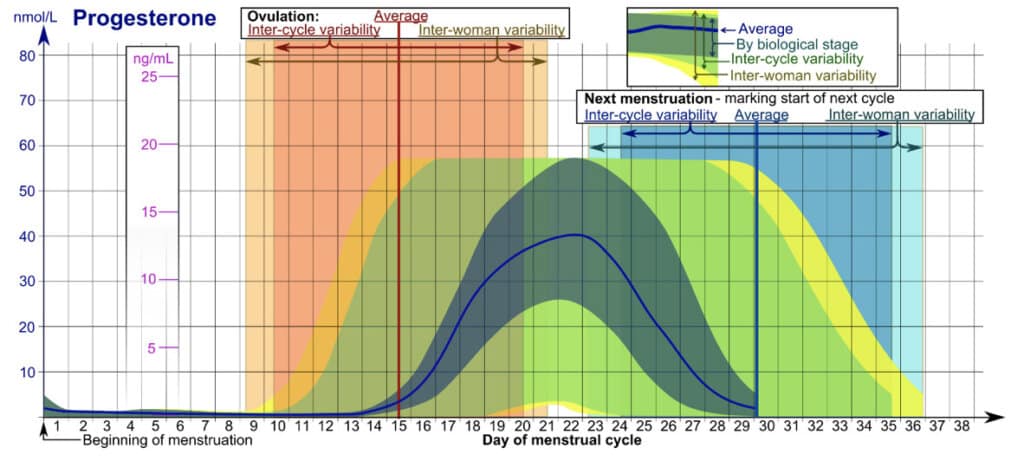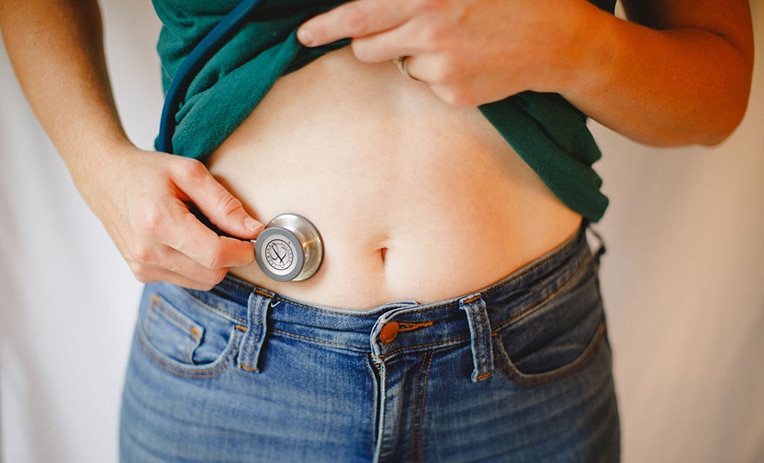What is Progesterone
Progesterone is the hormone we all know and love. Progesterone is a sex hormone that is produced primarily in the ovaries. It helps thicken the uterine lining so a fertilized egg can implant in the uterus. In the first part of the menstrual cycle, the follicular phase, progesterone levels are low. Luteinizing hormone stimulates the release of an egg and after ovulation occurs progesterone levels begin to increase. The luteal phase begins after ovulation occurs and generally lasts around 14 days. The follicle that released the egg becomes a corpus luteum and starts making progesterone. Progesterone functions include:
- Increasing body temperature (tracking basal body temperature is one way to estimate whether ovulation has occurred!)
- Thickening mucus in the cervix- this prevents bacteria and sperm from entering the uterus

How is progesterone produced?
Progesterone is made from pregnenolone, which itself is made from cholesterol. Most progesterone is produced by the ovaries and corpus luteum but the adrenal glands are responsible for producing small amounts. Cortisol (the stress hormone) is also made from pregnenolone and when a person is under chronic stress, cortisol will be produced at the expense of progesterone.

When to get tested
Women who have trouble conceiving or have a history of miscarriages should get their progesterone levels tested. Progesterone testing is usually done around days 19-21, i.e.,mid-luteal phase. Progesterone levels can be tested and monitored via blood, saliva or urine. Progesterone levels fluctuate throughout the day, a urine or saliva sample will represent levels over the full span of the day.
How to interpret progesterone lab results
High: If results are high it most likely indicates ovulation has occurred. Other causes for high progesterone are pregnancy, ovarian cancer, adrenal cancer, and congenital adrenal hyperplasia.
Low: Low progesterone levels point to anovulation (no ovulation) but further testing should to rule this out. Charting basal body temperature, ultrasound, and repeated testing can further validate ovulation has taken place. Common causes for low progesterone are: stress, extra weight, and lack of exercise.
Optimal Range Progesterone (serum)1,2
10-20 ng/ml

How to naturally improve progesterone levels
Protein and B6
Progesterone increases protein breakdown in the luteal phase3, so it’s especially important to stay nourished with essential amino acids (the building blocks of protein). Most sources of protein are rich with vitamin B6 which can also improve progesterone levels4.
Some sources of complete proteins include:
- Eggs
- Soy milk
- Chicken
- Wild-caught fish
- Edamame
- Tofu
Zinc
Eating foods high in zinc can increase progesterone levels by telling the pituitary gland to release follicle-stimulating hormone (FSH).
Food sources high in zinc include:
- Shellfish
- Legumes
- Seeds
- Nuts
A healthy diet
Maintaining a diet that is rich in vegetables, lean proteins, healthy fats, and complex carbohydrates will help balance blood sugar. Keeping a stable level of blood sugar improves the insulin response and can maintain insulin sensitivity. Progesterone increases the insulin response in the luteal phase so eating low glycemic foods will help balance hormones and improve chances of fertility5.

Herbs
- Chasteberry (Vitex) can improve the chances of conception by raising progesterone levels and decreasing estrogen6,7. Keeping these two hormones in balance is important in optimizing fertility.
- Organic Maca is an adaptogenic herb that enhances hypothalamic and pituitary functioning and increases progesterone levels8. Either of these herbs can be used in addition to diet and lifestyle changes.
Take it easy
Reducing stress is one of the most important things to do when improving progesterone levels! Since cortisol will steal the building blocks of progesterone, reducing cortisol will naturally improve progesterone levels. If stress is unavoidable, make time to walk at lunchtime, read, meditate, or take part in any relaxing activity.
Sources
1. https://www.ucsfbenioffchildrens.org/tests/003714.html
2. https://www.mayocliniclabs.com/test-catalog/Clinical+and+Interpretive/8141
3. Lysine requirement- 2004
4. https://www.ncbi.nlm.nih.gov/pubmed/6684167
5. https://academic.oup.com/ilarjournal/article/45/2/160/789454




